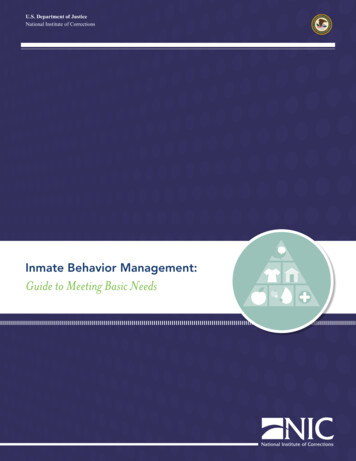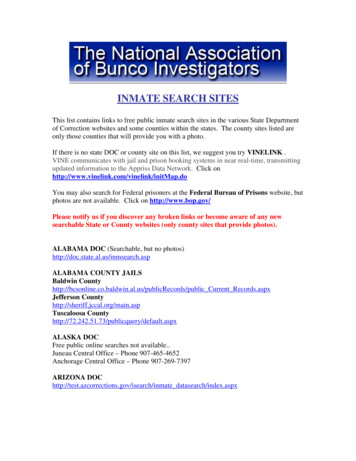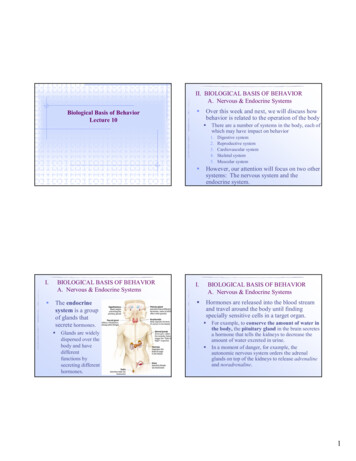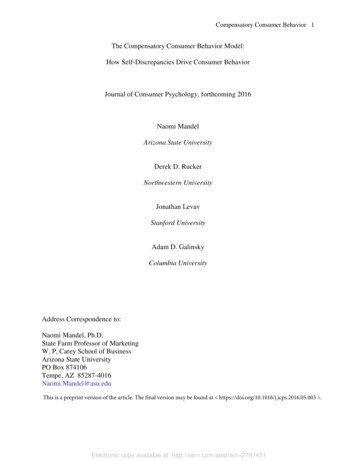
Transcription
U.S. Department of JusticeNational Institute of CorrectionsInmate Behavior Management:Guide to Meeting Basic Needs1
U.S. Department of JusticeNational Institute of Corrections320 First Street, NWWashington, DC 20534Morris ThigpenDirectorThomas BeauclairDeputy DirectorVirginia HutchinsonChief, Jails DivisionFran ZandiProject ManagerNational Institute of Correctionswww.nicic.gov2
Inmate Behavior Management:Guide to Meeting Basic NeedsScott Hoke, Ph.D. and Randy DemoryFebruary 2014 NIC Accession Number 0277043
DisclaimerThis document was funded by cooperative agreement number 10J74GKD7 from the National Institute of Corrections,U.S. Department of Justice. Points of view or opinions stated in this document are those of the authors and do notnecessarily represent the official position or policies of the U.S. Department of Justice. The National Institute ofCorrections reserves the right to reproduce, publish, translate, or otherwise use and to authorize others to publishand use all or any part of the copyrighted material contained in this publication.Feedback Survey StatementThe National Institute of Corrections values your feedback. Please follow the link below to complete a user feedbacksurvey about this publication. Your responses will be used to assist us in continuing to provide you with high-qualitylearning and information n NumberNIC Accession Number 027704
Table of ContentsForeword . vChapter 1: The Importance of Meeting Inmates’ Basic Needs. 1Chapter 2: Meeting Basic Needs and How the Concept Contributesto Inmate Behavior Management . 5Physical Needs.6Safety Needs.6Social Needs .7Emotional Needs .8Chapter 3: The Roles of Various Jail Divisions in Meeting Inmate Needs . 11Security Division.11Medical Division.13Maintenance, Housekeeping, and Laundry .13Food Service .14Inmate Programs.15Training Division.15Administration .16Chapter 4: The Connection Between Basic Needs, Inmate Misconducts, and Grievances . 21Chapter 5: Self-Assessment of Basic Need . 29Self-Assessment .30Outside Independent Assessments .33Inmate Satisfaction Surveys .33Training Scenarios .34Chapter 6: Monitoring Implementation . 37Data Collection .37Quantitative Data .37Qualitative Data.39Personal Observation .39In-Depth Interviewing .40Group Discussion .40Triangulation .40Data Analysis.42Chapter 7: Conclusion. 45Chapter 8: Using the Resource Materials. 49Incident Spreadsheet.49Incident Summary .49Grievance Spreadsheet.49Grievance Summary.50Self-Assessment —Physical Needs .50Self-Assessment—Safety Needs .50Self-Assessment —Social Needs .50Self-Assessment Results.50Inmate Satisfaction Survey.50Inmate Survey Results.50Bibliography . 53Appendices . 55Appendix A.57Appendix B .61Appendix C.65iii
Message from the DirectorViolence, vandalism, and other unwanted inmate behaviors prevail in many jails nationwide, and they frustrate jailpractitioners who must ensure the safety and security of inmates, staff and the public. Jail environments are one of the fewenvironments in our communities where this type of behavior is expected and accepted. The environment created by thesebehaviors should not be considered acceptable and it is the jail administrators’ responsibility to operate their facilities in away that prevents these behaviors from occurring.Relatively few resources make it challenging to provide assistance and detailed direction to administrators on how best tooperate such a complex organization. National Institute of Corrections (NIC) has introduced an initiative designed to:teach administrators, managers, and corrections officers the most effective methods to control inmate behavior and optimize operationalefficiency. NIC calls the initiative Inmate Behavior Management or IBM. The comprehensive management system has sixidentifiable elements that work together to manage inmate behavior and create an efficient and effective organization(Hutchinson, Keller, and Reid 2009):1Assessing risks and needs2Assigning inmates to housing3Meeting inmates’ basic needs4Defining and conveying expectations for inmates5Supervising inmates6Keeping inmates productively occupied7Defining and conveying expectations is one in a seriesof documents or tools for jails practitioners to use as theyimplement this management strategyA Guide to Meeting Basic Needs offers practical information and guidance on implementing element three — meetinginmates’ basic needs. One important aspect of managing inmate behavior is to understand what motivates human behavior.Experience has shown that if a jail does not meet the basic human needs of inmates, the inmates will find a way to satisfy theirneeds in ways that may be unfavorable to the orderly operation of the jail. Understanding what motivates human behaviorprovides jail administrators with a very useful tool for managing inmates since it helps explain both good inmate behaviorand bad.This document not only provides guidance to jail practitioners as they implement this element, but it also provides selfassessment checklists to determine how well the jail is doing in the delivery of basic needs and suggestions for area ofimprovement. It is our hope that by using these tools corrections professionals will realize the benefits of improvedinmate behavior.Morris L. ThigpenDirectorNational Institute of Correctionsv
Chapter 1: The Importance of Meeting Inmates’ Basic NeedsInmate Lambert has been in jail only a few days, but between the constant noise, the cold cell, and hisworries about court procedures, he has been unable to get even one decent night’s sleep. Finally, in themiddle of another sleepless night he pushes the button on the intercom in his cell. A voice barks, “What’syour emergency?” Lambert replies, “If you don’t get me out of this cell and put me some place I can sleep,there will be an emergency!” The voice says, “Shut up and press your bunk. You’re not going anywhere.”Angered, Lambert grabs his thin blanket, stuffs it into the toilet, and begins to flush repeatedly until wateris gushing under the cell door and cascading down the block. Within an hour, Lambert is relaxing inside hisnew, quiet, isolation cell.This scenario illustrates the types of jail management problems that may arise from a failure to meet an inmate’s basic humanneeds. Security personnel can continue reacting to specific acts of inmate misbehavior, or they can institute a system forcontrolling inmate behavior that prevents acts like this from occurring in the first place. Such a system has been developedby the National Institute of Corrections (NIC), which has identified six elements of an inmate behavior management plan: iAssessing Risksand NeedsAssigning Inmatesto HousingMeeting Inmates’Basic NeedsDefining andConveyingExpectationsfor InmatesSupervisingInmatesKeeping InmatesProductivelyOccupiedJail administrators have long recognized the behavioral benefits of some of the individual elements, but taken together,these six elements allow jail administrators to deploy a complete “operating system” that effectively manages the behaviorof the inmates in their custody. Implementing these elements puts the control of the jail in the hands of staff, not inmates.A properly implemented inmate behavior management (IBM) plan influences inmates to desist in unwanted behaviors (e.g.,assaults, theft, disobeying orders) while at the same time encouraging more appropriate behaviors. With the creation ofthe IBM initiative, NIC has defined a multifaceted jail management operating system that maximizes the effectiveness ofproven practices.The starting place for IBM is to assess each inmate for risk and needs. “Risk” is defined as how dangerous an inmate is to theinstitution, and “needs” are defined as the physiological or psychological requirements for well-being. These risk-and-needsassessments help determine whether inmates should be accepted for admittance to jail, how best to manage them in the intakearea, and how to manage them later in population. A jail’s system of assessing risk and needs is commonly called inmateclassification.1
What Happens When Staff Do NotManage Inmate Behavior Effectively?The following are among the negative inmatebehaviors that administrators have identifiedwhile attending NIC inmate behaviormanagement training: Vandalism of jail property Stealing Disruptive behavior Loudness Abusiveness Fighting Inappropriate sexual behavior Manipulation of staff Attempts at self-harm Intimidation of others Contraband Hoarding Fashioning weaponsElement Two of IBM is assigning inmates to proper housingwithin the jail, based on a well-defined housing plan. Usingthe results of the risk-and-needs assessment to make aninformed decision about housing placement enables staff tomanage inmate behavior effectively.The third element of IBM involves meeting inmates’ basichuman needs. One understanding of this topic is based onthe categorization of human needs in the work of psychologistAbraham Maslow (1943). His categories included physicalneeds, safety needs, love needs, and esteem needs. While caselaw has clearly established a jail’s legal obligation to meet basichuman needs, IBM acknowledges that if a jail does not meet thebasic human needs of inmates, the inmates will find a way tosatisfy their needs on terms that may be unfavorable to orderlyjail management.Element Four involves setting positive expectations for inmatebehavior, and then successfully conveying those expectations tothe inmate population. Positive staff expectations for inmatesand how those expectations are conveyed have a powerfulinfluence on inmate behavior. Experience has shown thatstaff can influence inmate behavior by setting high standards,conveying those expectations, and giving the inmates the meansto comply. These positive expectations need to be supported bya system of incentives for desired behavior and disincentives todiscourage unwanted inmate behavior.The fifth element of IBM is supervising inmates to hold themindividually accountable for their behavior. Staff presencein inmate-occupied areas and positive staff interaction withinmates will result in desired inmate behavior. Skills suchas decision making, problem solving, communication, andmotivation contribute to the effectiveness of this element.This document focuses on Element Three, which is meeting inmates’ basic humanneeds. It is intended to be a resource for jail administrators and others interestedin exploring this topic with a view towards improving inmate behavior.2
The final element is keeping inmates occupied withproductive activities. Productive, staff-directed activitiesprovide a powerful incentive for inmates to behave. Whencontinued access to meaningful and desired activities is tiedto appropriate behavior, inmates are motivated to meet theexpectations of staff. Providing activities gives staff a means toreward positive inmate behavior.This document focuses on Element Three, which is meetinginmates’ basic human needs. It is intended to be a resourcefor jail administrators and others interested in exploring thistopic with a view towards improving inmate behavior.This document will: Review the concept of basic human needsand relate it to inmate behavior. Identify the services and activities in a jailthat satisfy inmates’ basic human needs. Suggest a mechanism for analyzing inmatemisconduct related to basic needs. Provide a self-assessment checklist to enableadministrators to examine where their jail isnow in the delivery of basic needs. Suggest areas for improvement.EndnotesiV. Hutchinson, K. Keller and T. Reid, Inmate BehaviorManagement: The Key to a Safe and Secure Jail (Washington DC:U.S. Department of Justice, National Institute of Corrections,2009).What Are the Benefits of ManagingInmate Behavior?The following are among the benefits that resultfrom improved management of inmate behavioras identified by administrators attending NICinmate behavior management training: Increased cleanliness Fewer complaints Motivation to work Better reentry skills Better morale Safer jail Fewer incidents Better risk management Increased financial savings Better work environment for staff Fewer confrontations Better consistency Better public image Less stress3
4
Chapter 2: Meeting Basic Needs and How the Concept Contributes to InmateBehavior ManagementOne important aspect of managing inmate behavior is understanding what motivates human behavior. Thosewho study behavior suggest that the drive to satisfy basic human needs is a prime motivator behind whatpeople do and the choices they make. Because inmates are human, an understanding of what motivateshuman behavior provides jail administrators with a useful tool for managing inmates. It helps explain bothgood inmate behavior and bad.One of the more well-known theories of human motivation is that advanced by Abraham Maslow in his 1943 paper, A Theoryof Human Motivation, and in his subsequent writings. Maslow states succinctly that “[m]an is a perpetually wanting animal.” iThis means that a human will experience a want or need, such as hunger, become motivated to meet that need, and then act in amanner intended to satisfy it. A hungry inmate, just like a hungry person in the free world, will take actions intended to satisfyhis or her hunger, even if it means breaking a jail rule along the way. As Maslow put it, “all capacities are put into the service ofhunger-satisfaction,” ii meaning that hungry inmates will make it their full-time job to find a way to satisfy that hunger.Maslow identified five primary needs and arranged them in a hierarchy. These needs, in order of their primacy, arephysiological, safety, love, esteem, and self-actualization. These needs have been applied to business, education, and mostother manners of human enterprise. They will be defined in greater detail below and their relationship to managing inmatebehavior will be explained. Maslow’s premise was that the more basic, or more immediate to sustaining life, one’s needs are,the more they would command the attention of the person feeling those needs. Meeting those needs would trump all otherconcerns and activities. As Maslow pointed out, when one cannot breathe, or if one were dangerously hungry, the urge towrite poetry or the desire for a new pair of shoes is forgotten, or at least becomes of secondary importance.For the purposes of inmate behavior management (IBM), we emphasize the concept that needs, not a hierarchy, are what drivebehavior. A quick search of the Internet will reveal dozens of lists of “needs.” They are arranged in lists of three, seven, nine,or more than fifty. Some lists present needs as primary, some as equal, and others as part of an interconnected system of giveand take. Using Element Three to manage inmate behavior does not require acceptance of Maslow’s hierarchy, but it doesrequire an acknowledgment that inmates, like other humans, will act to ensure that their basic human needs are met.Maslow identified five primary needs and arranged them in a hierarchy.These needs, in order of their primacy, zation5
The world of advertising is another discipline that understands needs. The easiest way to motivate customers to purchase aproduct or service is to make them feel a need for it, even if the advertiser has to create a need in the process. To sell smokealarms, insurance, or elective surgery, the advertiser appeals to the need to feel safe. To sell cosmetics or beauty aids theadvertiser tweaks everyone’s innate desire for love or to be welcomed socially. Some sports cars or designer labels appeal toour desire to have power and control. The principles behind writing advertising copy and managing inmate behavior arethe same — in both cases, an influencer uses an understanding of needs to motivate exactly the kind of human behavior thathe or she desires from other people.PHYSICAL NEEDSPhysical needs are the things, such as air, food, water, and protection from the elements, that support physical existence.In a broader context, you could also consider things such as adequate warmth, exercise, sanitation, and medical care asphysical needs. Like all people in their normal environments, inmates will work to satisfy their physical needs by seekingsufficient food, adequate warmth, physical activity, medical care, clean clothes, and sanitary living quarters.People in jail are in confinement, meaning that they are totally dependent on corrections officers for meeting theirbasic physical needs. If the food carts do not arrive, they go hungry. If the sink breaks, they go thirsty. If the heatermalfunctions, they get cold. In the free world, people have options and they can generally meet their physical needs withoutbreaking the rules of society. However, even in the free world, if someone’s physical needs are dangerously deprived, thatperson will readily become impolite, then aggressive, next a rule-breaker, and finally a law-breaker if that is what it takesto satisfy a basic human physical need. Although few of us have had the opportunity to see how we would behave in the faceof starvation, we can confess to being rude or grouchy if we miss even a meal or two.How do people who are in jail behave when we don’t meet their basic human physical needs? Inmates sometimes findthemselves hungry or uncertain about the availability of future nutrition. This could be because they came to jail severelymalnourished, because of inadequate food service in the jail, or perhaps because their food is sometimes stolen by otherinmates. Their only available response to this need almost always involves breaking a jail rule, because they generally arenot permitted to request seconds from the jail kitchen, go to the cupboard for snacks, make a quick run for fast food, orvisit the fridge in the middle of the night, all of which are responses that any one of us who are not incarcerated make everyday. Those responses being unavailable to inmates, the inmates resort to tricking corrections officers out of additionaltrays, stealing commissary from cellmates, or strong-arming extra food from weaker inmates. While jails have rules againstthose sorts of things, need-based theories of motivation predict that humans will forsake obedience to rules when facedwith a serious deprivation of a basic human need. With inmates being human, they will act in this predictable manner.SAFETY NEEDSA safety need is the general feeling humans have to protect themselves, or to be protected from anything that can hurt them.Our need for safety is what prompts us away from risky behaviors and causes us to order our lives so that we are generallyprotected from harm coming either from other people or from our environment. This need for protection from harmdoes not disappear when someone is incarcerated; in fact, we could argue that inmates are keenly aware of the need to protectthemselves from harm.Right or wrong, many inmates perceive harm coming to them potentially from other inmates, their environment, and eventhe security staff — and the inmates will act accordingly. If an inmate feels there is likelihood that he could be attacked by acellmate, that inmate may fashion a weapon for protection. An inmate who feels unsafe will do this even if he was the typeof person who never armed himself in the free world, or even if the jail has rules against fashioning a weapon. A weak orvulnerable inmate may attempt to increase the odds of his personal safety by raising his status among the aggressive inmates.Typical tactics of this sort include provoking a fight or assaulting an even weaker inmate, or threatening or “going off on”6
a corrections officer at a moment when his predators are assembled as an audience. Another very common inmate behaviorthat is evidence of being motivated by the safety need is when a vulnerable inmate gets himself moved from generalpopulation into a single segregation cell by threatening to harm himself, or by purposefully committing a rule violationthat he knows will lead to his punishment and isolation. All of these are examples of unwanted inmate behavior that wecould reduce if we helped inmates feel safe in the jail environment they are confined in.Interestingly, Maslow pointed out that another indication of our need for safety is the very common human preference fora kind of routine in our lives. He points out that one indicator of a child’s need for safety is his preference for “some kindof undisrupted routine or rhythm. He seems to want a predictable, orderly world.” iii We want to have a predictable, safe,orderly, organized environment in which to live. Anything that jolts us out of the rhythm or routine of our lives makes usfeel anxious or unsafe, and we generally characterize that event as unjust or unfair. Maslow said, “the peaceful, smoothlyrunning, ‘good’ society ordinarily makes its members feel safe enough.” iv Being humans, inmates also seem to prefer a jailenvironment that is safe, orderly, and predicable, in which unexpected or dangerous things do not happen. Experiencedadministrators have learned to establish routines and order in their jails. In fact, “clean, safe, and orderly” are all acceptedhallmarks of a well-run jail. It is no accident that the “clean, safe, and orderly” characteristics all refer to basic human needs.SOCIAL NEEDSMaslow said that humans will “hunger for affectionate relations with people in general.”v We express this need in ourdesire for social connections of all types, as many different types of interactions satisfy this need. It is easily observedin one’s desire to keep connected with family and friends, but it is also expressed and felt in any one of the dozens ofways humans come together socially around activities such as sports, worship, politics, performances, or travel. It isthe need expressed in the words of the theme song for the sitcom Cheers: “ you wanna go where everybody knows yourname.” However, in the corrections environment, we sometimes recognize social needs in common “us versus them”manifestations such as gang membership or the other criminal subcultures. In the absence of more normal socialinteractions, some inmates withdraw and become depressed, which undoubtedly contributes to the high incidencesof self-harm or suicidal behavior in jails.Social needs are keenly felt, and unfortunately the security apparatus that is typical of incarceration has the net effectof disrupting the social connections a person had in place prior to coming to jail. While legal repercussions and familymember reactions to one’s criminal behavior threaten to unsettle one’s pre-existing social relationships, the physicalbarriers of incarceration literally interrupt normal social intercourse.Jail inmates react to these interruptions in a predictably human manner; they attempt to re-establish them even though itmeans struggling against the rules that jail administrators have put in place to protect the security of the institution. Forexample, if the rules permit only family members to visit, inmates will try to present girlfriends or boyfriends as familymembers. If inmates have no money to place a phone call, they will manufacture a “family emergency” in an attempt tomanipulate a free call, or they will steal a phone card from another inmate (while knowing that if the theft is discoveredby the other inmates it will likely jeopardize a safety need in the future).Jail administrators routinely put rules in place that directly affect the inmates’ abilities to meet social needs. Jails havelegitimate security concerns that lead them to regulate inmate mail, visiting, or other activities, such as time out of one’scell or how many inmates can be in the recreation yard at any one time. Achieving a balance between security concernsand inmates’ basic human social needs is one of the challenges of our profession. It does not help our efforts to manageunwanted inmate behavior if administrators are blind to inmates’ social needs when they make security decisions. Humansare social beings, and incarceration does not change or suspend that. Those working in jails would do well to consider howmuch inmate behavior, both good and bad, is motivated by a hunger
inluence on inmate behavior. Experience has shown that staff can inluence inmate behavior by setting high standards, conveying those expectations, and giving the inmates the means to comply. These positive expectations need to be supported by a system of incentives for desired behavior and disincentives










